| Boybuloq | |
|---|---|
| Boy-Bulok, Boj-Bulok | |
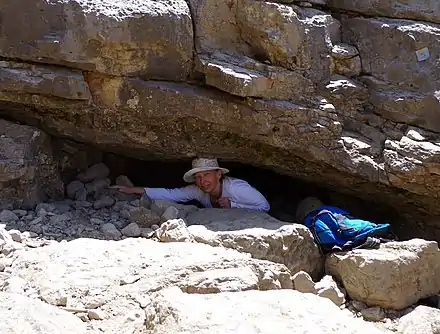 Cave entrance | |
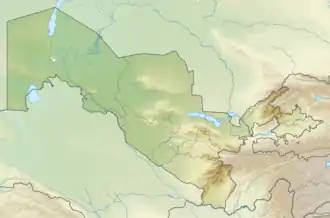 | |
| Location | Dehibolo, Uzbekistan |
| Coordinates | 38°23′04″N 67°30′06″E / 38.384470°N 67.501690°E |
| Depth | 1,517 metres (4,977 ft) |
| Length | 18,400 metres (60,400 ft) |
| Elevation | 2,647 metres (8,684 ft) |
| Geology | Jurassic limestone[1] |
| Entrances | 2 |
Boybuloq (also known as Boy-Bulok and Boj-Bulok,[lower-alpha 1] Uzbek: Boybuloq, Russian: Бой-Булок) is a limestone cave in Uzbekistan, the deepest cave in Central Asia and all Asia except its western part. The cave is 1,430 metres (4,690 ft) deep and 15,212 metres (49,908 ft) long with the main entrance at an elevation of 2,647 metres (8,684 ft). It is situated at the edge of Baysun-Tau mountain ridge, the southern spur of the Gissar Range, in the southeast of the country. The nearest village is Dehibolo (Дюйбало in Russian), to the northeast of Boysun.[2][3][4][5][6]
The cave developed in the covered karst of Upper and Middle Jurassic limestones, in monoclinal strata, in the preserved wing of an anticline. The thickness of limestone strata is from 200 to 350 meters. Contrary to most limestone caves it was not formed by water precipitation penetrating from the surface but, as the soluble rock is covered by insoluble strata, by condensation.[1] Hence the cave consists mainly of very narrow passages which descend along the incident angle of strata, from time to time interrupted by vertical shafts, no deeper than 30 metres (98 ft), and ends with an impassable siphon.[5]
It was explored by Russian cavers since 1984, in the framework of Ekaterinburg Speleo Club (SGS) and the Assoсiation of Ural speleologists (ASU), with the participation of cavers from Italy, Great Britain, Slovakia, France and Switzerland (in chronological order).[7][8]
Naming
After the rain a small stream, a rarity in otherwise very arid mountain, flows from the cave entrance and it gave the cave a name. It is a composition of two words: boy buloq, which translates to rich spring in Uzbek language and the language of the people from the nearest village, the Tajiki.[9][10]
Early history
.jpg.webp)
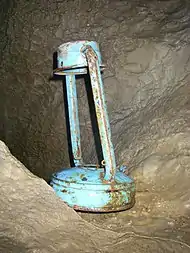
The cave was known to local people since ancient times, because from its entrance a stream of water flows down the slope of the otherwise very arid mountain landscape. In the winter the village Dehibolo at an elevation of 1,750 metres (5,740 ft), its name translates to "the highest village", is cut off by the snow, and later in the summer the few springs, which provide water to residents, can dry up.[11][12] In April 1971 Mustafo Zokirovič Holmominov (born 1917), a farmer from Dehibolo departed on a 4-hour trek to the cave (6 km)[13] with his son Hudojberdi (born 1957) on two donkeys. The cave was known to him, he visited it several times before. The two reached the cave and Mustafo went into the cave to pray. After a crawl of about one hour, he reached the point close to the first shaft, where his kerosene lamp went out. In the darkness he missed the direction towards the entrance, and fell to his death into the abyss. Hudojberdi waited at the entrance for two days when the villagers from Dehibolo came and returned him home by force.[14][15][9][16]
Young men from Dehibolo tried to find Mustafo in the cave on several occasions that summer and in the following years but to no avail. His remains were only discovered in 1985, during the first speleological exploration of the cave.[16]
Exploration

After the discovery of Kiev Cave on the Kirk Tau plateau in Uzbekistan in 1972, 2340 m a. s. l., which was in the subsequent years explored to the depth of 990 m and was in the years 1977-1978 the deepest cave in the USSR,[17] Russian speleologists from Ekaterinburg (SGS) in the late 1970s and early 1980s started to search for new deep caves in the wider area of the country.[18] In May 1981 they discovered the Zindan cave (later renamed to Urals-Zenkov (Zindan) cave), 3100 m a. s. l., in the Ketmen'-Čapta ridge. Its spring at the elevation of 1300 m indicated the possibility of a very deep cave. Until January 1983 the final depth of 565 m was reached, in the siphon too narrow to dive.[18][19] Several search expeditions in the summer 1983 were fruitless, while in 1984 a token SGS expedition to Khodja-Gur-Gur-Ata massif discovered a number of promising entrances.[16]
During a larger expedition in 1985 a group of five expedition members was sent to Surkhan-Tau ridge to scout its surface for new caves. On the way, in the village Kurgancha, 1455 m a. s. l.,[20] they were told of a cave higher in the mountain, called Boybuloq into which a villager from the highest settlement in Uzbekistan, the village Dehibolo, went in 1971 and never returned.[9][10] They followed the stream bed and discovered the low cave entrance, at an elevation of 2650 m. The cave began with 30 meters of a crawl, up to the throat in liquid mud, after which it was possible to stand up.[1] A narrow meander followed, it slowly ascended for 600 meters in straight direction, to a height of 90 meters, where it turned down.[12] Soon a 27 meter pit was reached and they discovered human bones at its bottom. They belonged to Mustafo Zokirovič Holmominov.[9][14]
Not only Boybuloq cave but most other caves in the area are a long sequence of tight passages which are difficult to pass, and where possibilities for help or rescue operation are very limited,[1] as described by Sergej Kuklev, a member of the SGS team:
I asked Ilija, trying to speak as calmly as possible, how, in his opinion, would it be more convenient to get through the tight meander, top or bottom? After some thinking he responded that the bottom choice would undoubtedly be more convenient. And so, I, flattened like a flounder, climbed in a hole under the rocks, barely wide enough for my head. And got stuck, of course. The caving suit, torn in all possible places, didn’t let go, so I had to stop to take a breath ... Only God or his/her own might can help a person which got stuck in Boybuloq - two people together just do not fit in a tight corridor. On one of previous expeditions it happened that a caver fell off a rope in a pit and, flying 17 meters, broke both legs. All we could do was to have painkillers ready at all times. It took him two days to crawl out of the cave on his own ...[1]

In the following years further expeditions took place: in 1986 the cave was deepened to -400 m, in 1987 to -500 m and the remains of Zokirov were returned to his family, in 1988 a siphon at -600 m was free-dived and also the barrier on the other side lowered so that the lake could be waded through, and a new branch of the cave was discovered - it continued to -900 m. In 1989 a combined Soviet-Italian team reached the terminal siphon at -1158 m, and managed to climb upwards to the point at an elevation of +156 m which gave the total cave depth of 1310 m.[5] In 1990 a Soviet-British team managed to extend the New branch in the cave upwards to +222 m (total depth 1376 m).[21] As can be seen from the above map this international participation in discoveries was reflected in the naming of three substantial cave sections: the Italian, English and Russian tunnels.
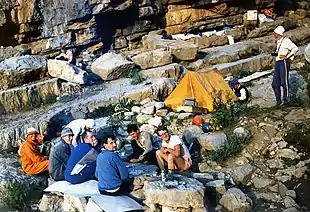

In 1991 lower levels of the New branch were discovered, and in 1992 an additional chimney upwards was climbed, to +257 m which gave the final cave depth of 1415 m.[16][3] In 1995 a major collapse in the cave was dug through, in 1998 the diving of the siphon at -560 m was unsuccessful, and the spring Holtan-Čašma, where the water from the terminal cave siphon comes to light, was also dived.[16] The spring is situated 130 m below the terminal cave siphon while the horizontal distance is 7 km, and so the connecting passages are most likely submerged.[9] In the next years the turmoil which followed the dissolution of the Soviet Union was unfavorable for caving expeditions and SGS cavers returned to Uzbekistan only in 2007, to Boybuloq, and expeditions followed almost every year.[22] New passages in Boybuloq were discovered and explored, yet the cave depth remained the same.[23] Diving in the Holtan-Čašma spring was resumed in 2014, 2015 and 2016, when, at a horizontal distance of 170 m and depth of 18 m, a lenticular grotto was reached with narrow, downwards extending slots, too narrow to pass.[24]
During the 2021 SGS and ASU expedition a survey team mapped the upwards extending tunnels in the New branch of the cave, explored in 2016. Survey data showed that the highest point achieved, where the tunnel narrows into an as yet impassable hole with very strong air current, is situated 272 m above the cave entrance. Boybuloq amplitude changed from 1415 m, achieved in 1992, to 1430 m and cave length increased to 15212 m.[3][25]
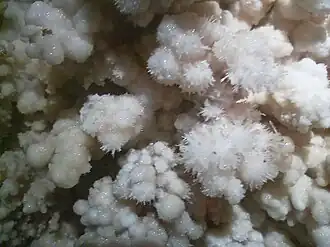

In 2022 a 20-member Russian expedition Boybuloq 2022 took place in August, again organized in the framework of SGS and ASU, led by Vadim Loginov. It only operated in Boybuloq. The base camp was established at 2.770 meters above sea level, 120 meters above the cave. The only goal was to explore any possibility of connecting the cave to Višnevskij. There were four working groups. The diving group of two explored three siphons. Two were too narrow to pass, the third they successfully dived through. Upstream a large tunnel followed, one of the two divers explored a short distance and returned. Exploration of this part of the cave was postponed, since a lot of equipment is required for climbing after the siphons. The scouting group, also of two, checked the side tunnels and meanders in the vicinity. They found several smaller tunnels which all ended in narrows. No draught in the direction of Višnevskij was found. The climbing group, again of two, explored the upper floors of the cave. They discovered several closed loops, of a chimney which led to a horizontal tunnel, ending with a pit that brought them down into the already known part of the cave. At the end of expedition they climbed a 170 meter high chimney, wide enough, which continued with a tunnel, presumably leading in the direction of the Višnevskij cave. Due to the lack of time they returned. The mining team of four was widening the narrows in the projected direction to Višnevskij cave. They advanced around 20 meters, there was no draught to follow. The cave depth did not change, around 1 km of new tunnels were explored, no survey was made.[26]
..jpg.webp)
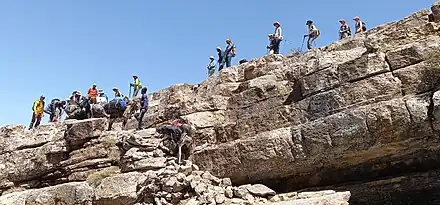
In 2023 a large, 33-member expedition, Russian with one participant from Taiwan and one from The Czech Republic, worked in August, in the same arrangement as in 2022. This year they operated in both caves, Boybuloq and Višnevskij. In Boybuloq the mining group worked at the closest point to Višnevskij, advanced 20 meters, no draught. The climbing group followed the tunnels and chimneys in the direction of Višnevskij. They discovered several new galleries, on top of the 170-meter chimney the tunnel continued for 666 meters and ended with a collapse. Speleothem samples were collected in the cave Lunnaja (Moon cave, which runs above the tunnels of Višnevskij cave) to be analysed at the Department of Geosciences, National Taiwan University. At the top of Boybuloq, in a tunnel 270 m above the cave entrance, a new underground camp was established from which a small group was expanding the narrow passage at the highest point of the cave, with a very strong air draft. They advanced 4 meters. Another group was working from the underground Camp Zero (it is at approximately the same elevation as the Boybuloq entrance). They climbed a few steps and chimneys and in one of them discovered a narrow tunnel which continued upwards in the direction of the top of the Chulbair ridge, to the wall on its eastern side. They passed 1.5 km of the tunnel, and surveyed part of it. On the last day of the expedition they measured the altitude of the last point reached with an altimeter considerably extending the amplitude of Boybuloq. The tunnel continues but they had to return due to lack of time. After the expedition Boybuloq had a new depth of 1517 meters and a length of 18.4 km.[27][26]
Višnevskij Cave

2015 In the year of the death of Aleksandr Sergeevič Višnevskij, leader of SGS expeditions to Boybuloq from 1988 - 1992 and from 1995 - 2008,[28] a SGS and ASU search team of 7, led by Vasilij Samsonov from Orenburg, methodically examined the 3 km long section of the 150–200 m high wall which forms the edge of the ridge above Boybuloq. They found several possible cave entrances, all located 30–50 m below the crest of the wall. The most promising proved to be the one marked as ČB-15 (Chul-Bair 15), with the coordinates 38°22′27″N 67°31′58″E / 38.374167°N 67.532778°E. The entrance is an 8 m high grotto at an elevation of 3522 m, 25 m below the top of the ridge, access requires a rope descent. It continued with a series of small shafts, connected by narrow meanders. 400 meters far and 70 meters deep the team stopped at a very narrow passage with strong draught. After 4 hours of work they broke the way through and it continued with a bigger shaft, which they left for the next year.[6][29]
2016 A team of 7, 4 Russians and 3 Italians (La Venta speleo club), from the Baysun-Tau 2016 expedition, worked in the cave. Due to long access route from the base camp (3 hours) part of the camp was moved to the top of the ridge. Situation there was complicated by the lack of water, strong wind and low temperature at night. The team widened the last narrow passage from 2015, descended 15 m into the hall "Martens" which continued with a very narrow but tall meander (3–30 m), followed by an inclined and very slippery meander. It ended with a 40 m shaft, 4–5 hours crawl from the entrance, at the bottom of which a Camp -168 was later erected. They followed the draught, and after a series of narrow passages, vertical and horizontal, which required widening, descended into a slightly wider meander with a small stream at the bottom. After 300 m a 12 m shaft was reached, after which the next meander led, as a tributary, to a wider and higher meander with a larger stream. It ended with a narrow passage which they broke through and reached another 8 m shaft, where the lack of time forced them to return. The surveyed part of the cave was deepened to 234 m and prolonged to 1089 m, with more left unsurveyed. The map showed that the cave, now renamed to Višnevskij cave, steadily descended in the direction of Boybuloq.[30][6]
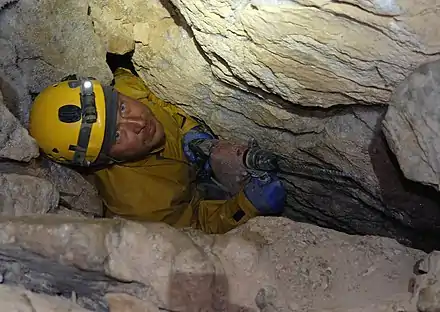
2017 A team of 10, from SGS and ASU, set camp above the cave, 3500 m above sea level. After a brief acclimatization they set up the tent underground Camp -168 from where Sergej Terehin and Artur Abdjušev pushed their way through the cave till the siphon at -735 m, in a day-and-night non-stop sortie. Another camp, of hammocks, was set up, the new part is a corridor, on average 50 cm wide, with a stream, into which 4 tributaries (unexplored) flow. The survey reached 586 m in depth and 2800 m in length, it showed that the cave descends steadily towards the New branch of Boybuloq, at an angle of 19 degrees, the same as the surface, at a distance from the surface of 70 – 100 m. Precise survey of the ridge surface was also made, for the construction of the 3D cave model. Part of the team scouted for additional cave entrances on the ridge plateau and along the wall, which would shorten the tiresome and time consuming crawl to the cave bottom. Several interesting caves were found, such as Lunnaja (Moon cave), U istočnika (At the Source), Logovo, they also worked in ČB-17, but none connected to Višnevskij cave.[6]


2018 An international team of 25, 14 from SGS and ASU, 8 from France and 3 from Switzerland set off to explore not only Višnevskij cave, but also caves Boybuloq, Lunnaja and ČB-5. They camped at an altitude of 3000 m, one hour from the entrance to Višnevskij and 1,5 hours from Boybuloq. In the cave two hammock camps were set up, at -350 m and at -600 m. Close to the lower camp, in a side tributary which continued in the opposite (ascending) direction, a small gallery was discovered, a hint of a possible continuation towards Boybuloq. In one of the other two tributaries examined, a large, 90 m tall chimney "Lucas Baldo" was found, which gets close (20 m) to the surface. Outside, in the canyon which leads to Boybuloq, dinosaur footprints were discovered, while in the new branch of this cave more precise survey was made for better location of the connecting point with Višnevskij cave. Siphon bypass was not found, but 2500 m of new tunnels were mapped in Višnevskij and Lunnaja caves.[6][4] [8][31][32][33]
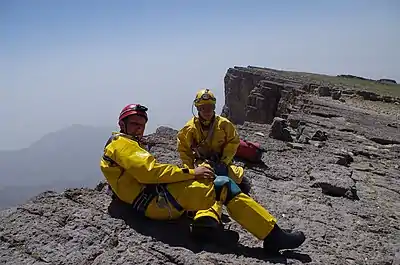
2019 It was difficult to assemble the expedition as there was no clear continuation, especially not around the siphon but, when cavers from Moscow and Irkutsk also joined the SGS and ASU team, a group of 15 gathered. The surface camp was set up in a proven location near Lunnaja cave, and a team of four: Evgenij Sakulin, Petr Kovešnikov, Anastasija Janina and Andrej Minogin departed to the bottom, to set a Camp Siphon there and to try to find a continuation in the ascending tributary at -600 m. Yet on the very first day at the bottom Evgenij and Anastasija managed to crawl through a narrow, half flooded passage and reached a meander behind the siphon. The cave continued in the right direction. Other plans were scrapped and the team, reinforced with Evgenij Rybka, Vasilij Samsonov and Vadim Loginov (there was a phone connection from the camp to the surface), set off to the new part. It was a wide meander with a stream at the bottom and 1–5 m deep drops. After a while the stream disappeared below the dripstone floor in a narrow passage, above which the "Big gallery" began. It was dry, the ceiling gradually lowered, the tunnel turned to a crawl, solid floor was replaced by clay, it got wet. This part took 2 hours to cross. The passage was cut by a new meander where, below the ceiling, the "Big Collapse Hall" opened up. The following meander was not wide, with a small stream at the bottom, in places covered with dripstone. Another tributary joined from the left.[6]
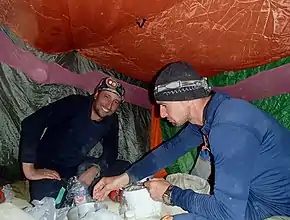
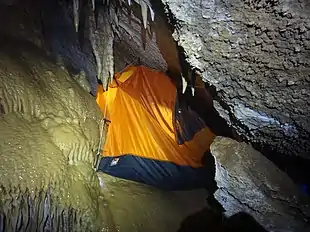
The passage continued with a few small drops which needed rigging. The beautiful colored meander was named "Amber River" because of the many dripstone formations. From the right came a larger inflow, most likely the main stream which disappeared in the floor before the "Big Gallery". The junction was named "Aquapark", crossing it required a run under a shower. On the left, under the ceiling of the meander, on a small shelf, the Camp "Gnezdo" (Nest) was set up. An even larger meander followed, with a stream of about 1 liter/second. It could seem very small, but for this arid mountain it is a lot. Soon a 12-meter drop, "Freerope" came, with a good shower, followed by 10, 8 and 12 m pits which also required rigging. The party stopped on top of another 20 m shaft, named "50 m rope", after which one more pit was visible. There were no more time, no more rope, no more anchors. The cave ran steadily in the direction of a cascade of pits in the New Branch of Boybuloq. Višnevskij cave was deepened to 1131 m and prolonged to 8004 m. In 2019 three underground camps were installed, at -168 m, -614 m and -1049 m, 2628 m of new tunnels were surveyed, 438 m of new depth.[6][34][29][35][36]
The deepest point reached in Višnevskij was 50 m vertically (above) and 200 m horizontally apart from Boybuloq. The connection would make a single cave with the depth of 2,033 metres (6,670 ft).[6]

2020 Due to the COVID-19 pandemic, the plans for a large expedition to caves of Chul-Bair mountain ridge, especially to the Višnevskij cave, were put on hold.[7]
2021 A window of opportunity opened up in June 2021 and an 18-member Russian-French-Slovenian-Uzbek expedition Boybuloq 2021 took place in August of that year. It was also organized in the framework of SGS and ASU, led by Vadim Loginov. The Višnevskij cave continued, after the terminal point reached in 2019, with a series of small pits, followed by a 30 m shaft. At its bottom there were several continuations. The cavers followed the water, and they reached a half-siphon, with little space from the water to the ceiling, followed by two more such half-siphons. The cave continued with a tunnel, with a drop of 20 m, where the water stream, about 10 L/sec., flowed into a large siphon. It would require diving, a dry bypass could not be found. After examining other options, the expedition managed to decrease the intercave distance to 70 m, between the two meanders in both caves, at approximately the same altitude above sea level, both still too narrow to pass.[3][34][25]
2023 Three teams of the Boybuloq 2023 expedition worked in the Višnevskij cave. The mining group was widening the narrows in the direction of Boybuloq, gained 35 meters, again there was no draught. The climbing group was exploring the tunnels on top of the chimneys. At the top of one of them they dug through to a tunnel which ended after 30 meters. The siphon draining group was emptying a smaller suspended siphon in the lower part of the cave, using hermetic bags. They managed to drain the siphon only halfway. A permanent connection between the two caves was also established, using Nicola phones. The best connection was also searched for with sounds from both sides (drilling, hammer blows). The best transfer of sound was near the siphon which was being dried, and the nearest tunnel in Boybuloq. According to the survey the distance between the two points is 70 meters but, due to the clear sound connection it is probably less than 50 meters. Višnevskij cave remained 1283 meters deep, its length increased to 8.6 km.[26]
Cave and the World
Discoveries in the Višnevskij and Boybuloq caves, achieved during the 2019 - 2023 expeditions, confirmed the assumption about the existence of a very deep, complex and wide-spread high-mountain cave system on the Chul-Bair ridge.[7]
In the world there are 14 mountains higher than 8,000 meters - the first was scaled in 1950 and the last in 1964 but only 2 caves are deeper than 2,000 meters.[37][38] Both so-called supercaves,[39] the last terrestrial frontiers, achieved that status half a century later, Krubera-Voronja (2,197 m deep) surpassed 2,000 m in 2004, after 44 years of exploration, Verëvkina (2,212 m deep) in 2017, 49 years after the discovery.[40][41] The anticipated connection of Boybuloq and Višnevskij cave would make the third such cave.[6] In 2001 the location of the deepest cave in the world moved from Central Europe to Abkhazia in the Western Caucasus where, as of 2020, the four deepest caves were to be found.[42] The possibility for achieving greater depths is however limited as the cave entrance elevations in the relevant limestone areas, the Arabika and Bzyb massifs, rarely surpass 2300 m (top peaks are Mt. Arabika, 2656 m and Mt. Napra, 2684 m).[43] The other two limestone areas with known great deep cave potential, are the Sierra Juárez, Oaxaca in southern Mexico with Chevé Cave where the limestone layer is over 2,500 m thick, and Aladaglar massif in Turkey with Kuzgun cave, with limestone layer thickness of 4,000 m. Yet despite very substantial efforts, over 40 years of work in Sierra Juárez and over 20 years in Aladaglar, no depth past the 1524 m and 1400 m, respectively, could be reached.[39][44][45][46]
All these facts considerably increased the attention, paid to Boybuloq, to Uzbekistan, and to central Asia, in the speleo world. Several regional projects were initiated, such as Research of karst and the caves of mountain Baysun-Tau, 2020-2021,[47] Karst on the Roof of the World (Pamir, Tajikistan), 2020-2021,[48] Central Asian transboundary speleoproject,[49] Speleological expedition “Tuya-Muyun - 2021 (Foothills of the Alai ridge, Kyrgyzstan).[50] Boybuloq and Chul-Bair were also added to the list of Uzbekistan tourist attractions.[51]
The cave was covered in the book of the visit by Italian cavers in 1989,[52] it featured in a report by BBC,[15] there are several pages devoted to it in the book by SGS, the team who developed the cave,[53] and it is the main subject in a novel by one of the team members.[54]
See also
Notes
- ↑ For greater accuracy Cyrillic names in this article are romanized according to Scientific transliteration of Cyrillic.
References
- 1 2 3 4 5 Kuklev, Sergej (1999). "Азия: туда и обратно" [Asia: round trip] (in Russian). Archived from the original on 11 June 2020. Retrieved 1 May 2020.
{{cite web}}: CS1 maint: bot: original URL status unknown (link) - ↑ Gulden, Bob (22 January 2020). "Worlds deepest caves". Geo2 Committee on Long and Deep Caves. National Speleological Society (NSS). Retrieved 16 February 2021.
- 1 2 3 4 Curihin, Evgenij (10 September 2021). "Бой-Булок (Бай-Булак)" [Boybuloq]. speleoatlas.ru - Caving atlas of Russia and the Commonwealth of Independent States (CIS) (in Russian). Русское географическое общество / Russian Geographic Society. Retrieved 11 September 2021.
- 1 2 Loginov, Vadim (11 March 2018). "Бой-Булок 2018" [Boybuloq 2018] (in Russian). SGS - Ekaterinburg speleo club. Retrieved 6 February 2021.
- 1 2 3 Curihin, Evgenij; Loginov, Vadim; Sauro, Francesco; Breitenbach, Sebastian (2014). "Exploration of High Altitude Caves in the Baisun-Tau Mountain Range, Uzbekistan". 2013 ICS (International Congress of Speleology) Proceedings / Exploration and Cave Techniques. pp. 147–152. Retrieved 28 May 2020.
- 1 2 3 4 5 6 7 8 9 Samsonov, Vasilij; Loginov, Vadim (12 April 2020). "История исследования пещеры им. А.С. Вишневского" [History of the exploration of A. S. Višnevskij cave] (in Russian). SGS - Ekaterinburg Speleo Club. Retrieved 9 February 2021.
- 1 2 3 "Who are we". SGS - Ekaterinburg speleo club. December 2020. Retrieved 7 February 2021.
- 1 2 Aigueperse, Antoine; Malard, Arnauld, eds. (December 2018). "Boy Bulok 2018" (PDF) (in French and English). Retrieved 9 March 2021.
- 1 2 3 4 5 Kuklev, Sergej (1999). "История исследования пещеры Бой-Булок (Александр Вишневский)" [History of exploration of Boy Bulok cave (Aleksandr Višnevskij)] (in Russian). Комиссия спелеологии и карстоведения / Speleology and Karst Studies Commission. Retrieved 1 May 2020.
- 1 2 Kuklev, Sergej (9 March 2011). "Средневековье Средней Азии" [Middle Ages of Central Asia] (in Russian). Сетевое издание "МК - Урал" (Московский Комсомолец) / Network Edition of "MK-Ural" (Moskovskij Komsomolec). Retrieved 27 May 2020.
- ↑ Jakopin, Primož (14 August 2021). "Boybuloq 2021 / Dehibolo". Retrieved 18 January 2022.
- 1 2 "Бой-Булок пещера" [Boybuloq cave] (in Russian). Meros.uz Культурное наследие Узбекистана / Cultural Heritage of Uzbekistan. 2015. Retrieved 26 May 2020.
- ↑ Curihin, Evgenij; Russkih, Ivan; Samsonov, Vasilij; Loginov, Vadim (2016). "БАЙСУНТАУ-2015 / Baysun-Tau-2015". In Evdokimov, Sergej (ed.). Журнал АСУ 27 [ASU Journal No. 23] (in Russian). Perm: The Assoсiation of Ural Speleologists. pp. 4–6. Retrieved 11 February 2021.
- 1 2 Jakopin, Primož (7 December 2021). "Hudojnazar Mustafokulovič Zokirov". Retrieved 18 January 2022.
- 1 2 Qobil, Rustam (27 December 2018). "Lost in Asia's deepest cave". British Broadcasting Corporation. Retrieved 4 May 2020.
- 1 2 3 4 5 Višnevskij, Aleksandr (2011). "История исследования пещеры Бой-Булок / Boy Bulok cave - History of exploration". In SGS - Sverdlovsk speleo club (ed.). СГС - Первые полвека. Пещеры. События. Люди [SGS - The first semi-centennial. Caves. Events. People.] (PDF) (in Russian). Azimuth Publishing, SGS - Sverdlovsk speleo club. pp. 65–66. Retrieved 1 May 2020.
- ↑ Snetkov, Evgenij (8 February 2018). "Киевская (КиЛСИ)" [Kiev Cave (KiLSI)]. speleoatlas.ru - Caving atlas of Russia and the Commonwealth of Independent States (CIS) (in Russian). Русское географическое общество / Russian Geographic Society. Retrieved 24 May 2020.
- 1 2 Višnevskij, Aleksandr; Zotov, Vladimir (2001). "Наша Азия / Our Asia". In Evdokimov, Sergej; Višnevskij, Aleksandr; Lobanova, Emma; Plastinin, Aleksandr; Valujskij, Sergej (eds.). СГС - 40 лет [SGS - 40 years] (in Russian). Vol. 6. Perm: The Assoсiation of Ural Speleologists. pp. 40–42. Retrieved 5 May 2020.
- ↑ Curihin, Evgenij (10 April 2017). "Уральская им. Зенкова (Зиндан)" [Urals-Zenkov (Zindan) cave]. speleoatlas.ru - Caving atlas of Russia and the Commonwealth of Independent States (CIS) (in Russian). Русское географическое общество / Russian Geographic Society. Retrieved 24 May 2020.
- ↑ Višnevskij, Aleksandr; Mal'cev, Vladimir; Dubljanskij, Viktor; Dubljanskij, Jurij (2004). "Крупнейшие пещеры Средней Азии" [The largest caves of Central Asia] (in Russian). Комиссия спелеологии и карстоведения / Speleology and Karst Studies Commission. Retrieved 6 February 2021.
- ↑ Vale, Paz; Wallis, Rob (1991). "Aspex '90". Caves and Caving. British Cave Research Association (52): 20–23.
- ↑ Čerepanova, Ol'ga (4 August 2008). "Стартовала экспедиция в Бой-Булок" [Expedition to Boy-Bulok started] (in Russian). Retrieved 2 May 2020.
- ↑ Potapov, Valentin; Jacucenko, Ekaterina (August 2012). "Часть 2 Камни на склоне" [Part 2 Stones on a Slope] (in Russian). Спелеоклуб Самарского университета / Samara University Speleoclub. Retrieved 26 May 2020.
- ↑ Sapožnikov, Georgij (2016). "Бой-Булок - исследования последних лет (2014-2016 гг)" [Boy-Bulok - explorations of recent years (2014-2016).]. Журнал АСУ / ASU Journal (in Russian). ASU - The Assoсiation of Ural Speleologists. 29: 5–6. Retrieved 23 May 2020.
- 1 2 Jakopin, Primož (11 September 2021). "Boybuloq 2021 / Expedition to caves of the Chul-Bair mountain ridge in Uzbekistan". Retrieved 11 September 2021.
- 1 2 3 Jakopin, Primož (21 September 2023). "Boybuloq 2022 and 2023 / Expeditions to Chulbair caves in Uzbekistan". Retrieved 2 October 2023.
- ↑ "Rekord chuqurlikda: Osiyodagi eng chuqur g'or – "Boy-Buloq"qa ekspeditsiya" [Depth record in Uzbekistan after an expedition to the Boybuloq cave] (in Uzbek). Ministry of Ecology, Environmental Protection and Climate Change of the Republic of Uzbekistan. 25 August 2023. Retrieved 2 October 2023.
- ↑ "Скончался основатель Ассоциации спелеологов Урала Александр Вишневский" [The founder of the Association of Speleologists of the Urals Alexander Vishnevsky died] (in Russian). obltv.ru / Sverdlovsk region TV. 16 June 2015. Retrieved 5 May 2020.
- 1 2 "The cave named Alexander Vishnevskiy". Tashkent: Asia adventures. 2019. Retrieved 7 May 2020.
- ↑ Loginov, Vadim; Samsonov, Vasilij; Curihin, Evgenij (2016). "Результаты Байсунской экспедиции - 2016" [The results of the 2016 Boysun expedition.]. Журнал АСУ / ASU Journal (in Russian). ASU - The Assoсiation of Ural Speleologists. 29: 3–4. Retrieved 23 May 2020.
- ↑ Nadjibayev, Marat (22 October 2018). "Boy-Bulok – deepest cave in Uzbekistan explored". kun.uz / News of Uzbekistan and the World. Retrieved 4 May 2020.
- ↑ "Russian cavers explored more than 30 caves in 2018". Russian Geographical Society. 18 December 2018. Retrieved 4 May 2020.
- ↑ "Спелеологи обнаружили следы динозавров при изучении глубоких карстовых пещер в Узбекистане" [Cave explorers discovered dinosaurs footprints during the study of deep karst caves in Uzbekistan] (in Russian). TASS. 31 August 2018. Retrieved 5 February 2021.
- 1 2 Curihin, Evgenij (10 September 2021). "Имени Александра Вишневского (ЧБ-15)" [Aleksandr Višnevskij Cave (ČB-15)]. speleoatlas.ru - Caving atlas of Russia and the Commonwealth of Independent States (CIS) (in Russian). Русское географическое общество / Russian Geographic Society. Retrieved 11 September 2021.
- ↑ "Sensational result of a speleological expedition in Uzbekistan". Tashkent: Pravda Vostoka. 29 August 2019. Archived from the original on 5 December 2020. Retrieved 4 May 2020.
- ↑ "Struggle for the underground "Everest" continues: Speleological expedition in Surkhandarya region ended with a sensational result". Uzbekistan National News Agency. 29 August 2019. Retrieved 4 May 2020.
- ↑ Herzog, Maurice (1951). Annapurna: First Conquest of an 8000-meter Peak. Translated from the French by Nea Morin and Janet Adam Smith. New York: E.P Dutton & Co. p. 257.
- ↑ "Shishapangma - Northeast Face - 1964". Himalaya Masala. 2013. Archived from the original on 21 April 2021. Retrieved 11 February 2021.
- 1 2 Ornes, Stephen (12 December 2015). "The hunt is on for the deepest cave". New Scientist (3051). Retrieved 11 February 2021.
- ↑ Klimchouk, Alexander (2012). "Krubera (Voronya) Cave". In White, William B.; Culver, David C. (eds.). Encyclopedia of Caves (2nd ed.). Cambridge, MA: Academic Press. pp. 423–450. ISBN 9780123838322. Retrieved 10 February 2021.
- ↑ Demidov, Pavel (11 September 2017). "По данным топосъемки глубина пещеры Верёвкина от входа составила 2204 метра" [According to the survey, the depth of Verëvkina cave from the entrance reached 2204 meters] (in Russian). incave.org. Retrieved 10 February 2021.
- ↑ Provalov, Denis; Grišina, Evgenija; Skljarenko, Dmitrij (24 March 2001). "Экспедиция "Крубера-Воронья - 2001" / (7.01.2001) Рекорд Мира!" [Expedition "Krubera-Voronya - 2001" / (2001-01-07) World Record!] (in Russian). Mountain.RU. Retrieved 11 February 2021.
- ↑ "Natural Heritage of Abkhazia". Abkhaz World. 24 August 2010. Retrieved 11 February 2021.
- ↑ Stone, Bill (2020). "2021 Sistema Cheve Expedition". U.S. Deep Caving Team. Retrieved 10 February 2021.
- ↑ Klimchouk, Alexander; Nazik, Lutfi; Bayari, Serdar; Tork, Koray; Kasyan, Yury (2004). "Kuzgun Cave and its Context: the first super-deep cave in the Aladaglar Massif, Turkey" (PDF). Retrieved 11 February 2021.
- ↑ Yamaç, Ali (2021). "45 Interesting Caves of Turkey". In Yamaç, Ali; Gilli, Eric; Tok, Ezgi; Törk, Koray (eds.). Caves and Karst of Turkey - Vol. 1 / History, Archaeology and Caves. Springer International Publishing. pp. 41–104. ISBN 978-3-030-65501-3. Retrieved 11 February 2021.
- ↑ "Special project - Research of karst and the caves of mountain Baysun-Tau. 2020-2021". Foundation for the Preservation and Exploration of Caves. 2020. Retrieved 2 June 2020.
- ↑ "Проект — «Карст на Крыше мира» (Памир, Таджикистан). 2020-2021" [Project - "Karst on the Roof of the World" (Pamir, Tajikistan). 2020-2021] (in Russian). Bishkek: Foundation for the Preservation and Exploration of Caves. 2020. Archived from the original on 21 April 2021. Retrieved 6 February 2021.
- ↑ "Центрально-Азиатский трансграничный спелеопроект" [Central Asian transboundary speleoproject] (in Russian). Bishkek: Foundation for the Preservation and Exploration of Caves. 2020. Archived from the original on 21 April 2021. Retrieved 6 February 2021.
- ↑ "Speleological expedition "Tuya-Muyun - 2021" (Foothills of the Alai ridge, Kyrgyzstan) August, 2021". Bishkek: Foundation for the Preservation and Exploration of Caves. 2020. Archived from the original on 7 March 2021. Retrieved 16 February 2021.
- ↑ "Boy-Bulok cave". Tashkent: Asia Adventures. 2020. Retrieved 16 February 2021.
- ↑ Bernabei, Tullio; De Vivo, Antonio, eds. (1992). Grotte e storie dell'Asia Centrale. Le esplorazioni geografiche del Progetto Samarcanda [Caves and stories of Central Asia. The geographic explorations of the Samarkand Project] (in Italian). Centro Editoriale Veneto. p. 307.
- ↑ SGS - Sverdlovsk speleo club, ed. (2016). СГС - В центре кадра [SGS - In the spotlight] (PDF) (in Russian and English). SGS - Sverdlovsk speleo club, Azimuth Publishing. pp. 58–67. Retrieved 1 May 2019.
- ↑ Kuklev, Sergej Gennad'evič (2016). В голове моей опилки... [In the head of my sawdust...] (in Russian). Aegitas. p. 239.